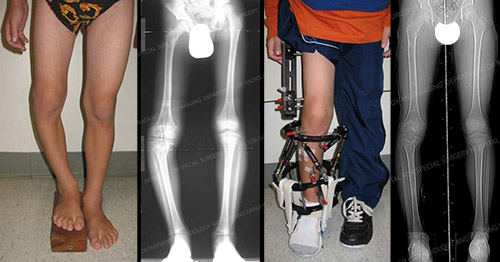Limb lengthening surgery is a sophisticated medical procedure to correct limb length discrepancies. Understanding the different types of surgeries available is crucial for those considering this life-changing procedure.
Who Needs Limb Lengthening Surgery?
Candidates for limb lengthening surgery range from children with congenital growth issues to adults who have suffered trauma or illness. Conditions like dwarfism or uneven limb length are common reasons for undergoing this surgery.
Limb lengthening surgery is not a one-size-fits-all solution; it is tailored to individuals with specific medical needs. The primary candidates include:
- Children with Congenital Conditions: Children born with congenital limb length discrepancy or dwarfism often undergo limb lengthening to improve functionality and appearance.
- Adults with Acquired Conditions: Adults who have suffered from severe injuries, bone diseases, or infections may require this surgery to restore limb functionality.
- Cosmetic Enhancement: Some individuals seek limb lengthening for cosmetic reasons, aiming to increase their height for personal or professional reasons.
- Post-Traumatic Corrections: Patients who have experienced traumatic limb injuries resulting in significant shortening may undergo limb lengthening to regain their original limb length.
- Health-Related Quality of Life: For many, this surgery is a path to a better quality of life, enabling them to perform everyday activities without discomfort or limitations.
Each case requires a thorough evaluation to determine if limb lengthening is the best action, considering the potential benefits and risks.
Types of Limb Lengthening Surgeries
There are several methods for limb lengthening, each with its unique approach and benefits.
External Fixation Method
This traditional method uses an external frame attached to the bone through pins and wires. While highly effective, it can be uncomfortable and requires meticulous care.
Internal Fixation Method (Precice Nail System)
A more modern approach involves an implantable device called the Precise nail, which extends the bone internally. This method is less invasive and offers quicker recovery but more expensive.
Combined Method
In some cases, external and internal methods are combined for optimal results. This is usually decided based on the patient’s specific needs.
Preparing for Limb Lengthening Surgery
Preparation involves thorough medical evaluations, psychological readiness assessments, and discussions about expectations and recovery.
The surgery is conducted under anesthesia. It involves precise bone cuts and the placement of external or internal devices to initiate the lengthening process.
Post-Surgery Care and Rehabilitation
Postoperative care is crucial for success. It includes wound care, pain management, and a structured rehabilitation program to regain strength and mobility.
Postoperative care and rehabilitation are critical components of the limb lengthening process, ensuring the success and safety of the surgery.
- Immediate Postoperative Care involves regular monitoring to manage pain, prevent infection, and ensure proper healing. The care team will frequently check the surgical site and the condition of the fixation device.
- Physical Therapy: Physical therapy plays a crucial role. It includes exercises to maintain joint mobility, muscle strength, and overall limb function.
- Lengthening Phase Care: During the lengthening phase, patients typically have frequent follow-up visits to monitor bone regeneration and adjust the lengthening device as needed.
- Psychological Support: The lengthy and demanding recovery process can be challenging. Psychological support and counseling can be beneficial for patients and their families.
- Home Care Instructions: Patients receive detailed instructions for home care, including wound care, signs of complications to watch for, and guidelines for activity levels.
- Long-Term Rehabilitation: After the desired length is achieved, rehabilitation focuses on strengthening the limb, improving functionality, and ensuring the patient can return to normal activities.
A successful recovery from limb lengthening surgery is a long-term commitment, requiring active participation from the patient and a dedicated healthcare team.
Cost and Insurance Considerations
The limb lengthening surgery Turkey price varies significantly depending on the type of surgery and location. Insurance coverage also varies, and patients should explore financial assistance options.
The cost of limb lengthening surgery can vary widely based on several factors:
- Type of Surgery: The choice between external fixation, internal fixation, or combined methods significantly influences the overall cost.
- Geographical Location: The cost can differ substantially depending on the country and specific medical facility.
- Surgeon’s Expertise: Surgeons with extensive experience and high success rates may charge more.
- Length of Hospital Stay: Longer hospital stays increase the overall cost.
- Rehabilitation and Additional Treatments: Post-surgery rehabilitation, physical therapy, and any unforeseen treatments add to the cost.
- Insurance Coverage: Insurance coverage for limb lengthening surgery is variable. Some insurance plans may cover the procedure if deemed medically necessary, while cosmetic lengthening is often not covered.
- Financial Assistance and Payment Plans: Some hospitals offer financial assistance programs or payment plans to help manage the costs.
Patients considering limb lengthening surgery should have detailed discussions with healthcare providers and insurance companies to understand the full financial implications and explore all available options for assistance.
Limb lengthening surgery offers hope for many facing limb length discrepancies. However, it requires careful consideration and consultation with medical professionals to ensure the best outcomes.
